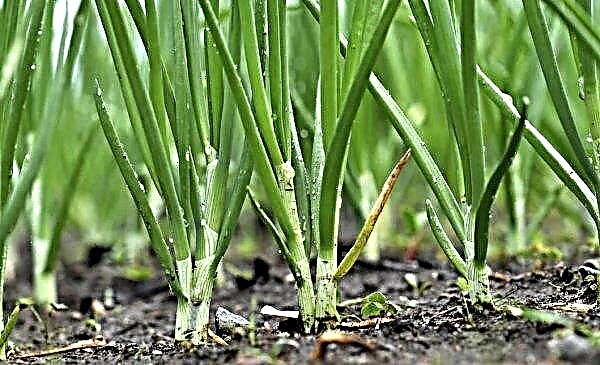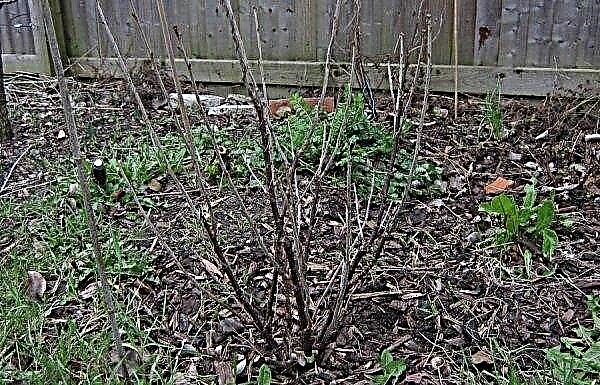Each beekeeper tries to keep the bees so that they are not sick. But sometimes there are cases when insects are affected by acarapidosis. The following is a description of the disease, its symptoms, causes and course. In addition, the features of diagnosis, as well as treatment methods and prevention, are considered.
Description of the disease
One of the insidious diseases of bees is considered to be acarapidosis (acarosis), which is characterized by slow development and late diagnosis. The disease is caused by microscopic mites of a microscopic form - Acarapis Woody.

The length of the female is from 160 to 190 microns, and the male is from 85 to 120 microns. Acarosis refers to invasive (parasitic) diseases. Pathogenic parasites are able to live exclusively in the bee's body, affecting the insect trachea and the base of the wings.
Did you know? In 1905, acarapidosis was first diagnosed on the Isle of Wight, where all bee colonies died as a result of infection.
Penetration into the trachea provides adult parasites and their larvae with nutrients. With a large-scale damage to the bee organism by pests, the tracheal gaps are filled with parasites, larvae, and also waste products. This leads to a lack of oxygen and, consequently, to the death of honey plants.

Outside the body of the bee, parasites do not live. They live on bee honeycombs and the walls of the hive for up to 5 days, and in a bee corpse - up to 6. High air temperature contributes to the rapid death of the parasite.
Insect disease occurs in two forms: latent and explicit. Hidden lasts for 2-3 years after infection. It is during this period that the disease is difficult to diagnose, damage to the insect proceeds to a weak degree. The explicit form is manifested at 4-5 year invasion of the entire apiary.
Symptoms of an invasive lesion
A disease can develop over several years if the beekeeper is not attentive to the health of his wards and does not process his hives. The following describes the process of how bees die during the development of the disease.
Did you know? After the uterus dies in the hive, the bees make a decision to withdraw a new one after 2 hours.
When the disease affects 50% of insects, the clinical manifestations of the disease are visible, including:
- increased size of the abdomen of the insect;
- anxiety state of honey plants;
- the presence of liquid emptying on the walls of the hive;
- A cluster of bees near the hive that crawl and bounce. Their wings are spread wide, directed in different directions;
- insects that are not able to take off are collected in heaps.

Causes of the disease
The causes of the disease include:
- Buying new honey plants. Acquire insects from reliable beekeepers. Purchased bees must be returned for veterinarian examination.
- The union of strong and weak families. This procedure is dangerous if the uterus has obvious signs of the disease.
- The presence of bee thieves or insects that swarm near the hive. With close contact with them, honey plants can become infected with ticks.
- The presence of dead bees inside the hive. The tick is able to live inside the inanimate organism of the bee for 6 days and can infect other individuals.
How does infection happen?
Active infection with parasites occurs in cold winter weather when healthy bees come into contact with infected ones. In order to warm the bees get closer to each other, which in turn leads to the active spread of the parasite.
 The bees of the Italian breed are most resistant to acarapidosis.
The bees of the Italian breed are most resistant to acarapidosis.
- When an insect enters the body, the pest causes:
- to metabolic disorders in the bee's body;
- deformation of insect wings;
- violation of the structure of muscles and cells of the outer bee cover.
Diagnostic Features
The disease can be determined only in laboratory conditions by examining the insect trachea through a magnifying glass.
Important! For diagnosis, it is recommended that from 3 affected families take samples of bees, 50 obviously sick individuals from each. After confirming the diagnosis, a second sampling of insects should be carried out.
In the course of the study, the stage of infection is determined:
| 3–6 day of infection | The walls of the trachea are covered with yellow spots, and ticks are clearly visible in the gaps |
| 2-3 weeks | The walls of the trachea become fragile and are covered by black currents. A large number of pests, their larvae and eggs are visible in the gaps |
| 27-30 day | Trachea turns brown, and in some cases black. Bee trachea overflowing with ticks, larvae, and also their waste products |
Laboratory studies are carried out for 5 days. An infected apiary and an approximate territory within a 5 km radius are quarantined.

Treatment Methods and Prevention
Treatment should be extended to all families, even those not infected with acarapidosis. Beekeepers process hives and replace all queens. The difficulty of treatment is due to the fact that the parasite is located inside the body of the insect. Drugs that enter through the hemolymph of the bee have an insufficiently effective effect on the body of the parasite.
Did you know? A healthy bee is able to perform a "dance in a circle" near the hive in the event that it finds a source of nutrition. If this dance is performed along a “wagging” path, then this means that the food is far away.
- To prevent infection with Acarapis woody ticks, it is necessary to adhere to the following recommendations:
- The apiary should be placed in a sunny, dry place.
- Acquire layering and uterus is necessary in nurseries, which guarantee the health of bee families.
- The use of previously infected hives and honeycombs is possible only after seven days of exposure and complete disinfection.
- If pests become suspected, all families should be treated.

Pharmacy drugs
Pharmaceutical preparations are recommended to use a long period of time. An effective method of treatment is fumigation of insects with acaricidal drugs. For processing, gaseous poisonous agents are used, the effect of which leads not only to the death of ticks, but also to bees.
This effect is noticeable when using the formicum preparation, which is made on the basis of formic acid. The drug is placed in the center of the nest, while ensuring good ventilation of the hive. Letki must be cleaned of propolis. Processing is carried out 3 times a week. Vapors kill not only ticks, but also infected queens.

When processing, you must strictly adhere to the instructions for use of the drug. In the fight against acarapidosis, plates soaked with special chemicals (Apifit, Akarasan) help. 1 plate is used per 10 frames. Processing should be carried out 6 times with an interval of 7 days.
In the autumn, it is carried out after the first flight. To effectively combat parasites, special dressings are used, which are made on the basis of sugar syrup with the addition of drugs. The Apimax drug is well suited for this.
Folk remedies
An effective folk method is the use of essential fir oil, which has a beneficial effect on honey plants. Strong ethereal coniferous odor kills the tick. Before using the oil, the hive must be covered with polyethylene.
Important! Processing is carried out in the daytime. In cloudy and damp weather, treatment should not be carried out, as the hive is poorly ventilated.
The upper notch is closed, and the lower one is opened by 1 cm. Fir oil is applied to gauze swabs. The drug is placed on top of the frames under the film. The procedure is repeated 3 times for 5 days. Menthol can also be used. For this, 50 g of crystalline menthol is placed on the bottom of the hive for a couple of weeks.
The effectiveness and results of treatment are determined by microscopic examination of samples of insects taken from the most infected families. When confirming the disease, the treatment should be repeated.
Video: Bee Fir Oil Processing
By familiarizing yourself with what bees acarapidosis is, you can protect insects by preventing disease. By identifying the causes and symptoms of its appearance, you will have the opportunity to choose treatment methods and rid the honey plants of the disease.












